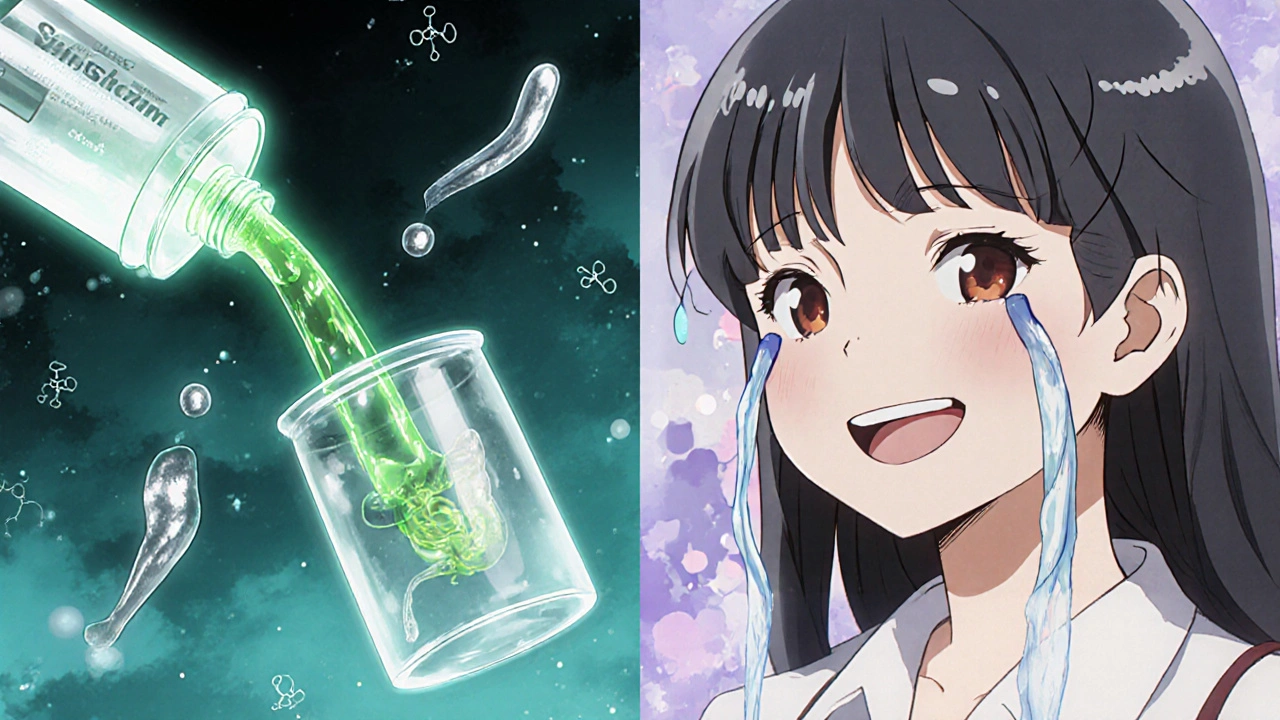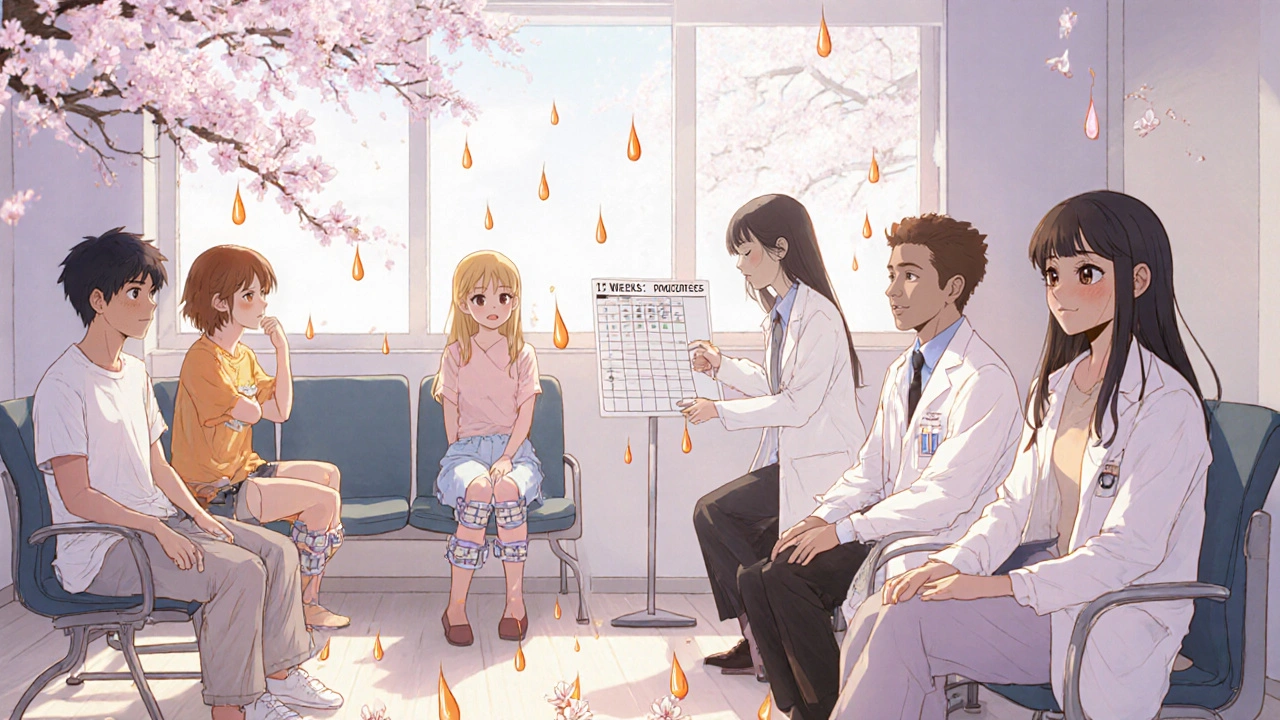How Sulfasalazine Helps Treat Reactive Arthritis
 Nov, 6 2025
Nov, 6 2025
Reactive arthritis isn’t just a stiff joint or a bad day. It’s a real condition that can turn simple movements into pain-filled challenges. Often triggered by an infection - like food poisoning or a sexually transmitted infection - it causes swelling, pain, and sometimes even eye or skin issues. And while rest and ice help a little, many people need something stronger. That’s where sulfasalazine comes in.
What Is Sulfasalazine?
Sulfasalazine is a medicine that’s been around since the 1940s. At first, doctors used it to treat ulcerative colitis, a gut inflammation condition. But over time, they noticed something else: patients with joint pain also felt better. Turns out, sulfasalazine works on the immune system in a way that calms down inflammation - not just in the gut, but in the joints too.
It’s not a painkiller like ibuprofen. It doesn’t numb the ache right away. Instead, it slowly reduces the body’s overactive immune response that’s attacking healthy tissue. This makes it a disease-modifying drug - meaning it can change how the disease progresses, not just mask symptoms.
Why Sulfasalazine for Reactive Arthritis?
Not every type of arthritis responds the same way. Rheumatoid arthritis? Sulfasalazine helps. Psoriatic arthritis? Also helps. Reactive arthritis? Yes - and here’s why.
Reactive arthritis is often linked to certain bacteria - like Chlamydia, Salmonella, or Campylobacter. After the infection clears, the immune system keeps firing. It mistakes joint tissue for the invader and starts attacking. That’s when swelling, stiffness, and pain show up - usually in the knees, ankles, or feet.
Studies show that sulfasalazine reduces joint swelling and tenderness in about 60-70% of people with reactive arthritis who’ve had symptoms for more than three months. It doesn’t work for everyone, but for those who don’t improve with NSAIDs alone, it’s often the next step doctors recommend.
How It Works in the Body
Sulfasalazine breaks down into two parts in your gut: 5-aminosalicylic acid (5-ASA) and sulfapyridine. The 5-ASA fights inflammation directly in the intestines. Sulfapyridine gets absorbed into your bloodstream and travels to inflamed joints. There, it interferes with immune cells that cause swelling and tissue damage.
This dual action is why sulfasalazine helps both gut and joint symptoms - especially useful if you’ve had reactive arthritis after a gastrointestinal infection. Some people with this condition also have mild IBD-like symptoms, and sulfasalazine can tackle both at once.
Dosing and How Long It Takes
You don’t take sulfasalazine and feel better the next day. It’s slow. Most people start seeing results after 4 to 8 weeks. Full benefit can take up to 12 weeks. That’s why it’s easy to get discouraged and stop taking it too soon.
Doctors usually start with a low dose - 500 mg once or twice a day - and slowly increase it over a few weeks. The typical maintenance dose is 1,000 to 2,000 mg per day, split into two doses. Taking it with food helps reduce stomach upset.
It’s important to stick with it. If you stop too early, you might miss the window where it actually starts working. And if you feel better after a few months, don’t quit without talking to your doctor. Stopping suddenly can cause symptoms to bounce back harder.

Side Effects - What to Watch For
Like all medications, sulfasalazine has side effects. Most are mild and fade as your body adjusts. Common ones include:
- Nausea or upset stomach
- Headache
- Dizziness
- Reduced appetite
- Orange-yellow discoloration of urine, sweat, or tears (harmless, but surprising)
More serious - but rare - side effects include:
- Liver problems (yellow skin or eyes, dark urine)
- Blood disorders (unexplained bruising, fever, sore throat)
- Allergic reactions (rash, swelling, trouble breathing)
If you notice any of these, stop taking it and call your doctor right away. Regular blood tests are usually recommended every few months, especially in the first 6 months, to catch any hidden issues early.
Who Should Avoid It
Sulfasalazine isn’t for everyone. You should not take it if:
- You’re allergic to sulfa drugs (like some antibiotics)
- You have a blockage in your intestines or urinary tract
- You have severe liver or kidney disease
- You’re pregnant or breastfeeding without medical supervision
If you have G6PD deficiency - a rare genetic condition affecting red blood cells - sulfasalazine can cause anemia. Your doctor might test for this before prescribing it.
Also, if you’ve had bad reactions to aspirin or other salicylates, talk to your doctor. Sulfasalazine is chemically related to aspirin, so there’s a small chance of cross-reactivity.
How It Compares to Other Treatments
When reactive arthritis strikes, doctors usually start with simple pain relievers: NSAIDs like naproxen or ibuprofen. These help with pain and swelling fast - but they don’t stop the disease process.
If NSAIDs aren’t enough after a few months, doctors turn to disease-modifying drugs. Sulfasalazine is often first-choice because it’s well-studied, affordable, and has fewer risks than biologics.
Other options include:
- Methotrexate: Works faster than sulfasalazine but carries more risk for liver and lung issues.
- Biologics (like adalimumab): Powerful, but expensive and require injections. Usually reserved for severe cases that don’t respond to other drugs.
- Corticosteroid injections: Great for a single swollen joint, but not for long-term use across multiple joints.
Sulfasalazine sits in the middle - not the fastest, not the strongest, but often the safest long-term option for moderate cases.

Real-Life Results
One patient in Sydney, 42, developed reactive arthritis after a bout of food poisoning. His knees swelled up, he couldn’t walk to the mailbox without pain, and his job as a carpenter was at risk. He tried ibuprofen for months - it helped a bit, but his joints kept flaring.
After starting sulfasalazine at 1,000 mg daily, he noticed less swelling after 6 weeks. By 10 weeks, he could bend his knees again. After 6 months, he was back on the job, with only occasional stiffness. He still takes NSAIDs when he overdoes it, but sulfasalazine keeps the flare-ups rare.
Another person, 35, had joint pain after a Chlamydia infection. Her doctor put her on sulfasalazine and she started feeling better after 8 weeks. Her eyes - which had been red and irritated - cleared up too. She’s been on it for 2 years now, with no major side effects.
What to Do If It Doesn’t Work
If you’ve taken sulfasalazine for 3-4 months and see no improvement, talk to your rheumatologist. It doesn’t mean you’re failing - it just means your body might need a different approach.
Some people respond better to methotrexate. Others need a biologic. In rare cases, reactive arthritis resolves on its own after 6-12 months. But if it’s dragging on past a year, it’s important to keep treating it. Chronic joint inflammation can lead to permanent damage.
Your doctor might order an HLA-B27 test - a genetic marker linked to reactive arthritis. If it’s positive, you’re more likely to have a longer-lasting form of the disease, and stronger treatment may be needed.
Living With Reactive Arthritis on Sulfasalazine
Managing this condition isn’t just about pills. Stay active. Gentle movement - walking, swimming, cycling - keeps joints flexible and reduces stiffness. Avoid high-impact sports that stress swollen joints.
Watch your diet. While no specific food cures reactive arthritis, some people find that reducing sugar and processed foods helps with inflammation. Omega-3s from fish or flaxseed might also help.
And don’t ignore mental health. Chronic pain can wear you down. Support groups, counseling, or even talking to others online can make a real difference.
Regular check-ins with your doctor are key. Blood tests, joint assessments, and open conversations help keep your treatment on track.
Final Thoughts
Sulfasalazine isn’t a magic bullet. But for many people with reactive arthritis, it’s the quiet hero that brings back mobility, reduces pain, and lets life go on. It takes patience. It needs monitoring. But for those who stick with it, the payoff is real.
If you’ve been told you have reactive arthritis and your doctor suggested sulfasalazine, give it time. Don’t give up after a few weeks. And if side effects bother you, don’t hide them - talk to your doctor. There are ways to adjust the dose, manage nausea, or switch safely if needed.
This isn’t a condition you have to live with in constant pain. With the right treatment, you can move again - without waiting for the next flare-up.
How long does it take for sulfasalazine to work for reactive arthritis?
Most people start noticing less joint swelling and pain after 4 to 8 weeks. Full benefits often take 12 weeks or more. It’s not a quick fix - it works slowly by calming the immune system, not just masking pain.
Can sulfasalazine cure reactive arthritis?
No, sulfasalazine doesn’t cure reactive arthritis. But it can significantly reduce symptoms and slow disease progression. For many, it prevents long-term joint damage and helps maintain daily function.
Is sulfasalazine safe for long-term use?
Yes, many people take sulfasalazine for years with no major issues. Regular blood tests are needed to monitor liver function and blood cell counts. Side effects like nausea or orange-colored urine are common but harmless.
What happens if I stop taking sulfasalazine suddenly?
Stopping suddenly can cause symptoms to return quickly, sometimes worse than before. Always talk to your doctor before discontinuing. They may recommend gradually reducing the dose to avoid flare-ups.
Can I take sulfasalazine with other arthritis medications?
Yes, many people take it with NSAIDs like ibuprofen for short-term pain relief. It’s often used alongside other disease-modifying drugs like methotrexate if needed. But never combine it with other sulfa drugs without medical advice.
Does sulfasalazine affect fertility or pregnancy?
In men, sulfasalazine can temporarily lower sperm count, but this reverses after stopping the drug. For women, it’s generally considered safe during pregnancy, especially when benefits outweigh risks. Always consult your doctor if you’re planning a pregnancy.


Brad Seymour
November 7, 2025 AT 04:26Sulfasalazine saved my life after my food poisoning turned into a nightmare knee situation. Took 10 weeks to kick in, but now I’m hiking again. People act like it’s some magic potion - nah, it’s just science working slow and steady. Don’t quit before the 8-week mark. I almost did.
Malia Blom
November 8, 2025 AT 07:15Let’s be real - this is just another Big Pharma trick to keep people hooked on pills. You think your immune system needs a chemical leash? Nah. Try turmeric. Or fasting. Or just… not being a walking inflammation sponge. Sulfasalazine? More like sulfasleepy.
Erika Puhan
November 9, 2025 AT 20:28While the pharmacokinetics of sulfasalazine are theoretically sound - particularly its dual-mechanism action via 5-ASA and sulfapyridine - the clinical efficacy data remains statistically marginal in non-HLA-B27-positive cohorts. Moreover, the risk-benefit ratio is questionable when compared to targeted biologics with higher specificity for TNF-alpha modulation. Why settle for a 60% response rate when precision medicine exists?
Edward Weaver
November 11, 2025 AT 12:03Y’all in the UK and India think this drug is some miracle cure? In America, we’ve got better options. Biologics work faster. Less nausea. Less orange pee. Why are we still using 1940s meds? This is like driving a Model T when Tesla’s right there. Sulfasalazine is for people who don’t have insurance that covers real treatment.
Lexi Brinkley
November 12, 2025 AT 02:43OMG I’M ON THIS DRUG RN 😭 it turned my orange pee into a party 🎉😂 but my knees? FINALLY NOT SCREAMING. 8 weeks in and I can wear shoes again. THANK YOU SCIENCE 🙏❤️
Kelsey Veg
November 12, 2025 AT 15:12so i took this stuff and my pee turned orange?? like… is that normal?? or did i just turn into a glowstick?? also my stomach hates me now. but my knee kinda stopped yelling at me?? idk man.
Alex Harrison
November 13, 2025 AT 13:13Been on sulfasalazine for 14 months now. Nausea went away after a month. Orange tears? Weird but harmless. My ankle stopped locking up. I still walk with a limp sometimes, but I can play with my kids again. Don't give up. It's slow, but it's real.
Jay Wallace
November 14, 2025 AT 22:16…And yet, the FDA has not approved sulfasalazine as a first-line agent for reactive arthritis in the context of modern immunomodulatory protocols - despite its off-label use being rampant in primary care settings. The lack of double-blind, placebo-controlled trials with >500 participants renders its efficacy… questionable at best. Also, why are we still using a drug that turns your tears yellow? This is medieval.
Alyssa Fisher
November 14, 2025 AT 22:17It’s fascinating how this drug bridges gut and joint inflammation - almost like the body doesn’t really separate them. Sulfasalazine doesn’t just suppress; it recalibrates. That’s why it takes so long. You’re not masking pain, you’re rewiring the immune system’s misfire. Patience isn’t optional - it’s the active ingredient.
Alyssa Salazar
November 15, 2025 AT 15:07As a rheumatology NP, I’ve seen patients rebound from near-immobility on sulfasalazine - especially when there’s concurrent subclinical IBD. The 5-ASA component is underrated. It’s not just a joint drug; it’s a gut-joint axis modulator. But yeah, the orange urine? Still weird. And yes, it’s harmless. No, you’re not leaking dye. You’re just biochemically glowing.
Beth Banham
November 16, 2025 AT 00:18I started this six months ago. Still take it. Still have bad days. But I don’t cry when I get out of bed anymore. That’s enough.